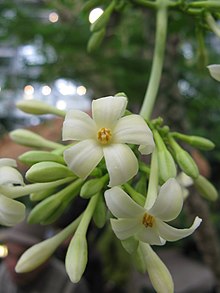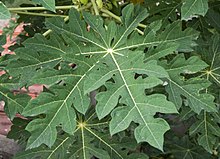The papaya is a large, tree-like plant, with a single stem growing from 5 to 10 m (16 to 33 ft) tall, with spirally arranged leaves confined to the top of the trunk. The lower trunk is conspicuously scarred where leaves and fruit were borne. The leaves are large, 50–70 cm (20–28 in) in diameter, deeply palmately lobed, with seven lobes. Unusually for such large plants, the trees are dioecious. The tree is usually unbranched, unless lopped. The flowers are similar in shape to the flowers of the Plumeria, but are much smaller and wax-like. They appear on the axils of the leaves, maturing into large fruit - 15–45 cm (5.9–18 in) long and 10–30 cm (3.9–12 in) in diameter. The fruit is ripe when it feels soft (as soft as a ripe avocado or a bit softer) and its skin has attained an amber to orange hue.
Common names
Carica papaya plants and their fruits are known by different names around the English-speaking world:- North America and Belize: papayas
- United Kingdom: The fruit is usually called papaya but is also known as papaw or pawpaw [2]
- Africa: pawpaw or papaw,[3][4]
Cultivation



Pests and diseases
| This section requires expansion. |
Main article: List of papaya diseases
Papayas are susceptible to the papaya ringspot virus (PRV), which causes premature molting and malformation of the leaves.[5] In the 1990s, the virus threatened to wipe out Hawaii's
papaya industry completely. Genetically altered plants that have some
of the virus's DNA incorporated into the DNA of the plant are resistant
to the virus.[5] Cultivars that had been genetically modified to be resistant to the virus (including 'SunUp' and 'Rainbow'), were then introduced there.[6] This was so successful that by 2010, 80% of Hawaiian papaya plants were genetically modified.[7] In 2011 Philippine researchers reported they by intergeneric hybridisation between carica papaya and Vasconcellea quercifolia they had developed conventionally bred, nongenetically engineered papaya that are proving resistant to PRV.[8]
In 2004, papayas throughout Hawaii were found to have hybridized with
the genetically modified varieties, and many seed stocks were
contaminated.[9]The papaya is also susceptible to the fruit fly, a small, wasp-like insect that lays its eggs in young fruit.
Tidak ada komentar:
Posting Komentar